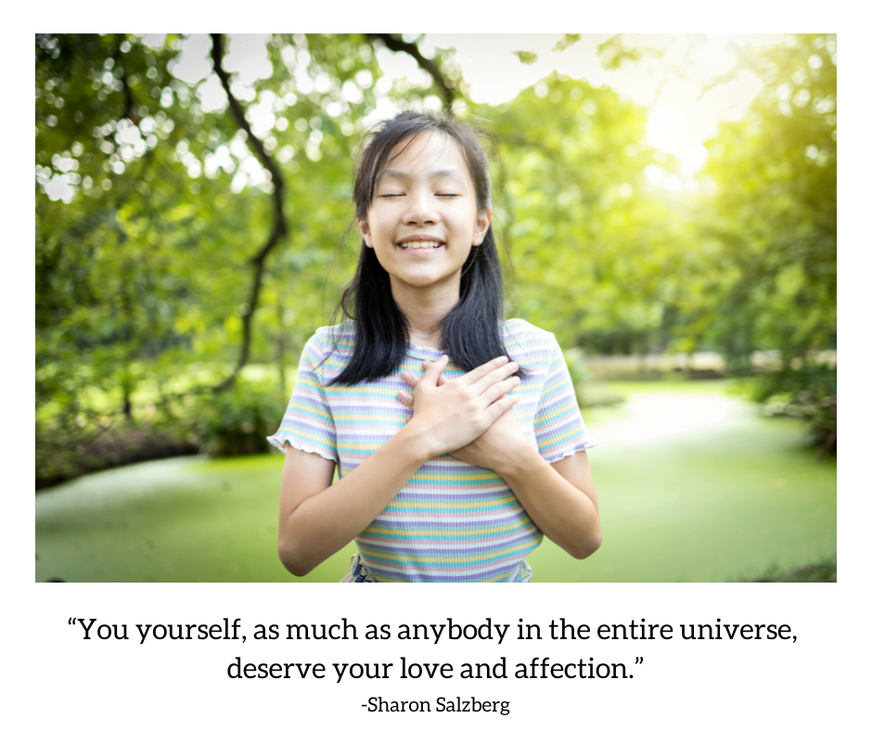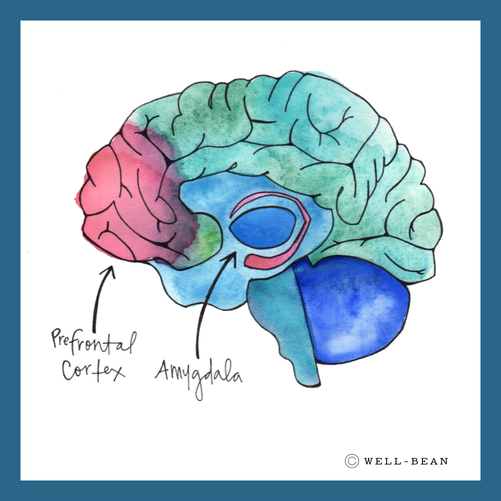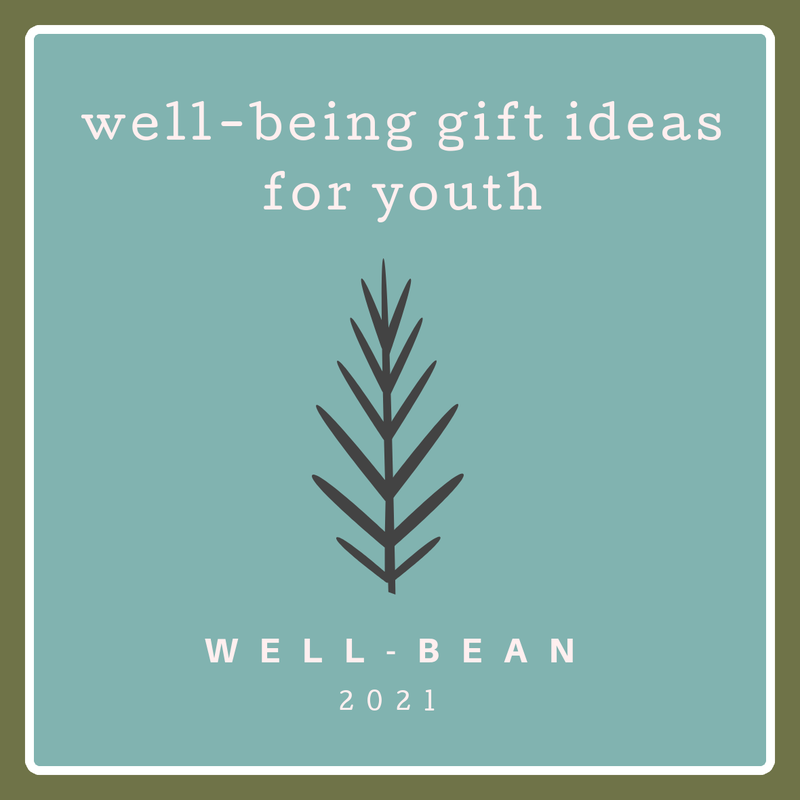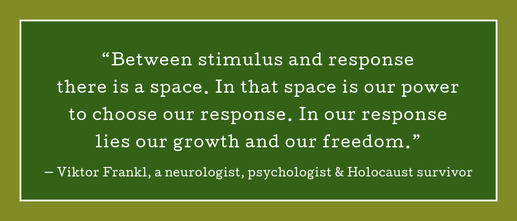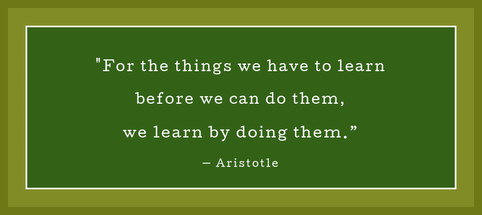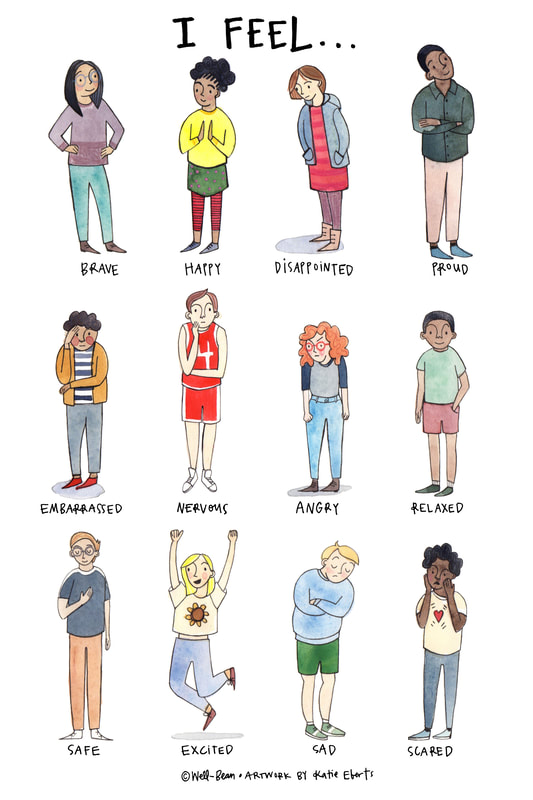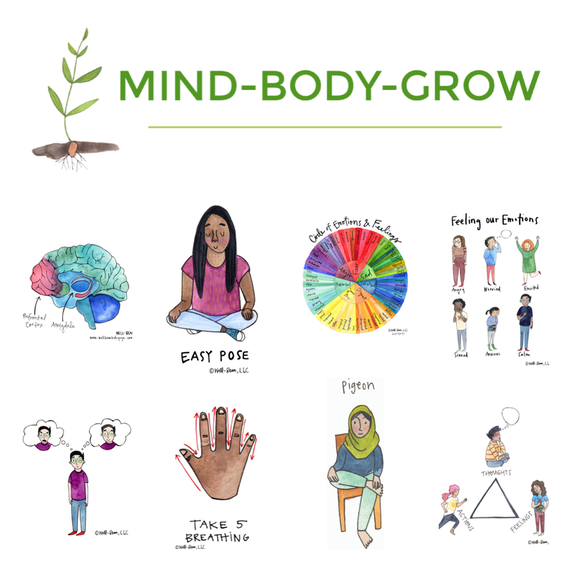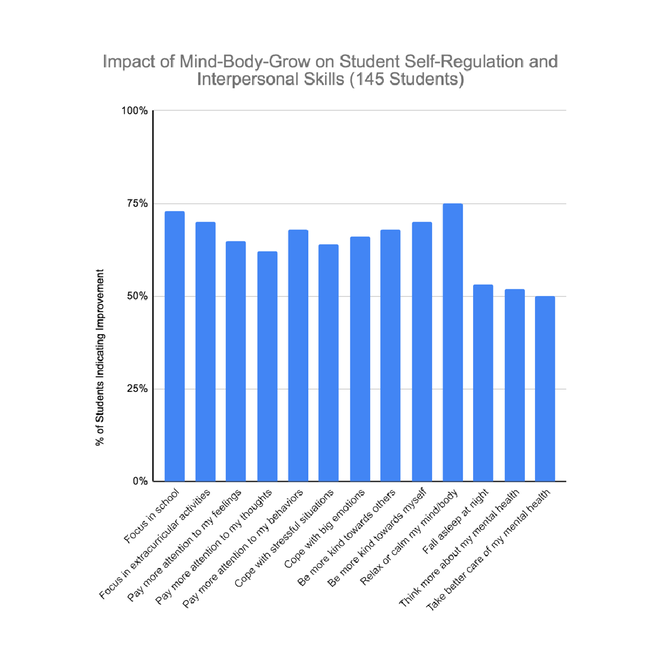|
In 2001, fresh out of graduate school, I began my practice as a school social worker at a time when self-esteem groups were a common intervention in the schools. I ran countless groups with curriculums that focused on feeling good about yourself, building self-worth, and evaluating yourself through a positive lens. But I always felt that these curriculums were missing something. I noticed that when life handed these kids a curveball - a failed test, peer conflict, or life not going as they had planned - their self-esteem would take a nosedive. What I was sensing is now more clear, based on resiliency research, it's the skill of self-compassion. We now understand the shortfalls of working solely on building one's self-esteem thanks in part to the pioneering work of Kristin Neff along with other scientists researching the field of self-compassion. “Self-esteem is often contingent on our latest success or failure, meaning that our self-esteem fluctuates depending on ever-changing circumstances. In our modern Western culture, self-esteem is often based on how much we are different from others. It is not okay to be average, we have to feel above average to feel good about ourselves. This means that attempts to raise self-esteem may result in narcissistic, self-absorbed behavior, or lead us to put others down in order to feel better about ourselves. The need for high self-esteem may encourage us to ignore, distort or hide personal shortcomings so that we can’t see ourselves clearly and accurately. Research indicates that in comparison to self-esteem, self-compassion is associated with greater emotional resilience, more accurate self-concepts, more caring relationship behavior, as well as less narcissism and reactive anger.” Self-Compassion is not based on self-evaluation, instead, it involves treating oneself as you would a friend, being gentler and more understanding of your life in the context of the larger human experience. All humans experience adversity, and being mindful of this shared experience helps us feel less isolated; it helps us see more clearly our interconnectedness and gives us permission to acknowledge, especially in challenging times, our challenges. Instead of asking “what’s wrong with me” or thinking "I’m a failure" it’s acknowledging “this is difficult”, and asking oneself, “what do I need to take care of myself?” Self-compassion is being emotionally supportive towards yourself when suffering or imperfection is confronted. We can model the action of compassion when we see a child struggling "I can see this is hard, I’m here with you.” Once we invite and allow space for children to feel and acknowledge their pain, they can learn to tend to how they feel from a place of self-worth. Questions like "What would you say to a friend right now?" or “What would feel comforting?” help them put self-compassion into action. We're not looking to change or negate how feel when we practice self-compassion, instead, we’re validating the emotional experience, and once we know how we feel, we're in a better place to take care of those feelings in a helpful and friendly way. Author, Jennifer Wilhelm Rapanos, LMSW, RCYT © Copyright 2020 Well-Bean, LLC. All rights reserved
When we've been taught to label weather as “good” or “bad” it can result in spending days and even weeks stuck inside escaping what we perceive as bad and avoiding the possibility of feeling uncomfortable. This common practice of categorizing and judging weather and allowing the conditions of each season to control our relationship with the natural world can have negative consequences. Especially when we consider the growing body of research that has advanced our understanding of how spending time in nature improves our mental health and well-being. And beyond our own benefit, research suggests that how we think about nature; our affective relationship with and the extent to which we see ourselves as part of nature, has an impact on nature’s wellbeing too. So in this season when we experience April showers maybe you consider paying particular attention to how you currently relate to rain. Have you been taught and conditioned to believe that rain puts a damper on the day? Do you complain about it and plan ahead so you don't get caught in the rain? What do your children hear from you, what are they learning about rainy days? The next time it rains maybe you pause to consider how rain is a necessary and precious resource. Maybe you grab a rain jacket or umbrella and head outside to reconnect to rain with presence and a sense of awe - spending a few minutes investigating the experience through your senses and with a child’s sense of wonder without the need for it to be different than what it is.
Learn more about how researchers are uncovering the benefits of experiencing awe by visiting Greater Good @ https://greatergood.berkeley.edu/topic/awe/definition#what-is-awe AUTHOR Jen Rapanos, LMSW, RCYT is a child and adolescent psychotherapist and the owner of Well-Bean, PLLC © Copyright 2023 Well-Bean, LLC. All rights reserved. I really enjoy teaching children about their brain. I think partly because it's information I wish I had known as a child. I often wonder, had I been taught the mechanisms for why and how my brain and body were designed to respond to stress, would I have been empowered to handle stressful situations a little differently? I was a pretty anxious kid. I remember feeling overwhelmed, a lot, I often internalized those feelings and questioned what was wrong with me. I learned to avoid situations that caused me stress and coped with feelings of anxiety by reacting out of fear and frustration. We often teach children to cope with their feelings by suggesting they practice universal strategies like "count to 10" "go for a walk" "take a breath." These strategies rarely worked for me. Without understanding why my heart was racing or why my stomach felt so awful or why I was so distracted, these coping strategy felt like useless old band-aids and the intention of changing my behavior rarely worked. At Well-Bean, before we teach children the skills for coping with big feelings we first teach them about the brain; how the brain was designed to keep us safe and how it reacts to threats. Then we move on and learn how to check in to those internal cues and experiences; the thoughts, feelings, and sensations that communicate that our stress response system has been activated. We learn how to pay attention to these cues from a place a curiosity and self-compassion which helps shift our mindset from "what's wrong with me?" to "ah, this is my amygdala (anxiety, fear, anger), my stress response system being activated." And then, with time, practice and adult support, we move on to learning how to monitor and regulate (manage) feelings and behaviors in a more mindful way. With younger clients we use kid-friendly language, visuals and props. The amygdala is kind of like a WATCH DOG. It has an important job of helping protect us from threats. We call it our protective brain because it is always looking out for our safety. When information comes into our brain and is interpreted as a threat, we respond immediately; this is our fight, flight or freeze response system. Our amygdala keeps us safe, however, our amygdala isn’t so good at figuring out if something is truly a threat. Stress and worry, a test, meeting someone new or dealing with drama a school can cause our amygdala to work overtime and instinctually cause us to react to situations without using our rational or thinking centers of the brain. When we teach kids to notice when their amygdala is activated we can then teach them how to practice using calming strategies so that they are better able to access another part of the brain which helps them manage their emotions and solve problems more skillfully. When the body and brain are calm, we are better able to access our prefrontal cortex (PFC). When our emotions and experiences are viewed through the lens of the PFC we have more choices, we can respond versus react to whatever is happening more mindfully; that’s why we say our PFC is like a WISE OWL. The PFC is our learning, reasoning and thinking center of the brain—it is the part of the brain that can see the big picture. It helps us control our impulses, focus our attention, and also helps regulate emotions. When the WISE OWL part of our brain is activated and the WATCH DOG is calm, we are better able to solve problems and manage feelings more mindfully. Teaching children to become more familiar with these key parts of the brain helps lay the groundwork for learning how to monitor and regulate their stress response system. Understanding what's happening in the brain can be the first step in empowering them to make choices. With this foundation they're better able to learn strategies to settle themselves in the face of stress and strong emotions; empowering them to access their more thoughtful, compassionate, creative and capable selves. AUTHOR Jen Rapanos, LMSW, RCYT is a child and adolescent psychotherapist and the owner of Well-Bean, PLLC © Copyright 2018 Well-Bean, LLC. All rights reserved.
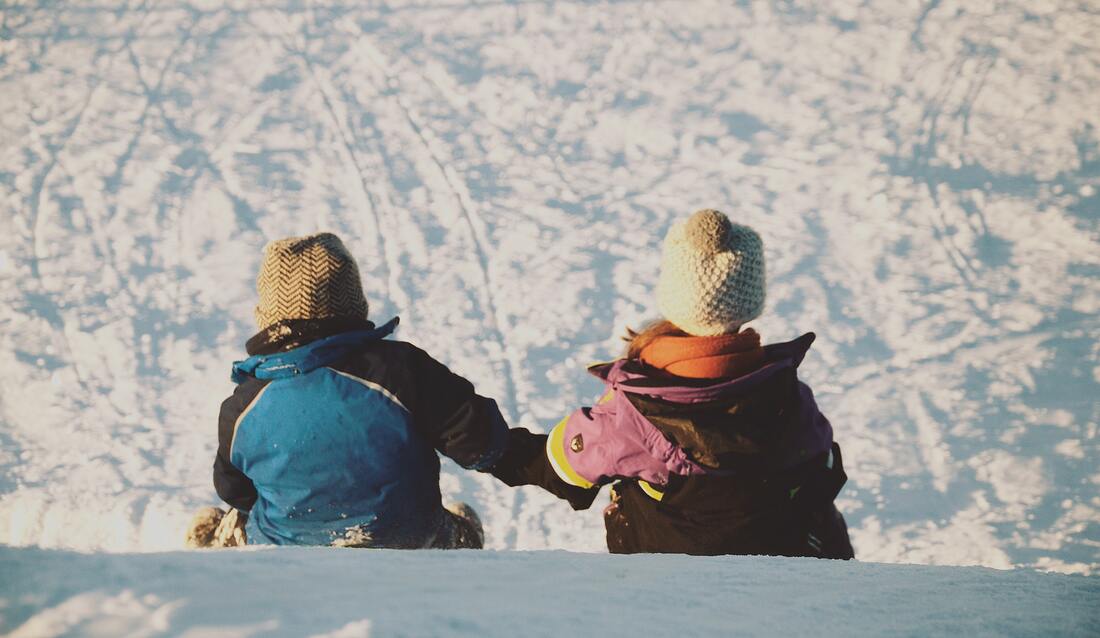 Image by Michal Janek @michaljaneck Image by Michal Janek @michaljaneck Shortened cold, gray and damp days are hardly elements that motivate us to get outside, right? We’re more inclined to associate winter as a time for rest and solitude, to repair and prepare for the spring when everything brightens and starts to bloom again. This may all be true, but when we allow the conditions of each season to control our relationship with the natural world, our preferences may result in waiting out the “uncomfortable” for the more “comfortable” and before we know it, we can end up spending days, even months stuck inside. When we consider the growing body of research that has advanced our understanding of how time in nature improves our mental health and well-being, it seems worthy to reconsider a typical conditioned response that has many of us avoiding the winter climate. Nature provides the ideal setting to observe our reactions to present moment experiences. Pause for a moment now, and imagine yourself preparing to spend the next 20-minutes outside no matter the conditions. What happens within your own internal landscape? Maybe you notice resistance, slight tension in your body, feelings of dread, maybe your mind creates negative thoughts about how this experience might unfold or excuses for why this is a bad idea? Or maybe, you welcome the proposal noticing a small burst of energy in your body and your mind is already preparing to bundle up for an adventure? Regardless of your current relationship status with the natural world, taking into account that nature is also the ideal setting for quieting the mind, calming the body, and resetting the nervous system, one might argue that it’s a relationship worth making space for. And beyond our own benefit, research suggests that how we think about nature; our affective relationship with and the extent to which we see ourselves as part of nature has an impact on nature’s wellbeing too. Whether it’s simply standing outside your front door to stretch and take a few full breaths of fresh air, gazing out the window to experience snowflakes gently falling to the ground, or mindfully taking a walk through your neighborhood, our hope is to encourage families to rediscover themselves in the natural world and to remind you of the richness of now when you set the intention to spend more mindful moments in the great outdoors. JEN RAPANOS, LMSW, RCYT IS A CHILD AND ADOLESCENT PSYCHOTHERAPIST WORKING IN PRIVATE PRACTICE AND THE OWNER OF WELL-BEAN, PLLC. WELL-BEAN'S MISSION IS TO INTEGRATE SCIENCE-BASED MIND AND BODY EDUCATION AND PRACTICES INTO THE LIVES OF YOUTH THROUGH THERAPY, COMMUNITY AND SCHOOL PROGRAMMING AND TRAINING. Copyright 2022 Well-Bean, PLLC. All rights reserved. www.wellbean.us It’s that time of year again! We're sharing some of our very favorite gift ideas and this year, we're thinking outside of the box when it comes to gift-giving! Our 2021 list includes presents that can be unwrapped as well as gifts of knowledge, connection, awareness, and experience. From our Well-Bean family to yours, wishing you a joyful and healthy season of celebration. LITTLE YOGI DECK This is hands down our favorite yoga & mindfulness card deck! 48 cards that are beautifully organized into eight color-coded categories—anger, worry, excitement, sadness, joy, jealousy, shame, and peace—to give kids specific practices for the variety of emotions they might be experiencing on or off the mat. Vibrantly illustrated, this card deck offers support and guidance for the child, parent, educator and caregivers. WILDER CHILD KIDS MOON CLUB This year-long journey is an invitation to strengthen your family’s bond with nature and create new traditions that will help you slow down, connect and sync up with the rhythm of the moon. Beautiful activities meant to bring families and communities together to celebrate through rituals all centered around the moon. The Kids Moon Club is filled with resources and activities for children ages 4-10 and families. You can only join this unique experience once a year, doors close on December 31, 2022. Click here to hear from creator, Nicollette Sowder CHANGE SINGS - A CHILDREN’S ANTHEM In this stirring, much-anticipated picture book by presidential inaugural poet and activist Amanda Gorman, anything is possible when our voices join together. As a young girl leads a cast of characters on a musical journey, they learn that they have the power to make changes—big or small—in the world, in their communities, and in most importantly, in themselves. SIMPLE MODERN - REUSABLE WATER BOTTLE Most children and teenagers don’t drink enough water; even mild dehydration can affect fatigue levels, mood and their ability to learn. We know that hydration is key to their health and wellness and so we’re turning to Simple Modern’s reusable water bottles to help! We appreciate this company's commitment to donating a minimum of 10 percent of their profits each year to helping others. In addition, they work to ensure their manufacturing process is as sustainable as possible. Stay hydrated and give back! BEN BROWN - SOUND HEALING We love this resource for teens - it’s an opportunity to engage in moments of rest and relaxation with sound practitioner and visual artist Ben Brown. Singing bowls, drumming and more, Ben combines his music making with mindful moments in nature providing the viewer with the healing power of rest, sound and connection to nature. Visit Ben’s Instagram page for mindful breaks to help settle and soothe the mind and body. LITTLE SCAVENGERS OUTSIDE JOURNAL Foster a lifelong connection with nature in your child with the Little Scavengers Outdoor Journal from Little Renegades. The journal includes thoughtful prompts and suggestions to encourage awareness, observations, and imagination in children as they explore the great outdoors. KABOOM! Play is the work of the child, yet far too many kids lack adequate places to play due to the ongoing effects of systemic racism. These inequities have left communities of color with less access to playspaces than their white counterparts, limiting their ability to fully experience the physical, social, and emotional health benefits of play. KABOOM! acknowledges this injustice, so they’ve created playspaces, in partnership with communities, to further long-term progress towards community-driven goals — goals that improve the lives of kids. We recognize the many ways that awareness, compassion and giving contributes to universal well-being. Explore how your family might give back this year and consider contributing to KABOOM! We encourage you to start with conversation and explore together, what is playspace inequity? How can we help with creating spaces for all children to play and thrive? JUST FEEL; HOW TO BE STRONGER, HAPPIER, HEALTHIER, AND MORE This is one of the very few books on social and emotional health that speaks directly to kids. Designed specifically with kids ages 8-12 in mind, the book clearly addresses important topics such as flexibility, responsibility, communication, creativity, and self-knowledge. Written by the respected writer and wellness expert Mallika Chopra, Just Feel effectively teaches kids how they can balance their emotions and make positive choices for themselves. Hear from creator, Mallika Chopra 1000 HOURS OUTSIDE The concept at the core of this movement is simple - the amount of time kids spend outside ‘actually matters’, though you may not hear this very often. A childhood flooded with nature time benefits kids (and adults) in untold ways. However, the spirit behind the journey is one of encouragement - not competition. 1000 Hours Outside is about striving for engaged time outside, and that looks different from one family to the next. Download one of their free and engaging tracker sheets and start your family’s commitment to spending more time in nature! I FEEL WELL-BEAN POSTER A feeling chart is a widely-used tool for building emotional awareness in children. While many feeling charts provide images of faces expressing emotion to help children identify and put a name to what they’re feeling, we intentionally created an “I feel” visual with characters that include the whole body. In this mindful work of teaching children skills for well-being, we recognize that effective emotional regulation includes the skill of paying attention to physiological cues. Because our bodies were designed to communicate, the I Feel poster encourages children to be curious about the important ways our bodies communicate emotions to us every day! Author Jen Rapanos, LMSW, RCYT child and adolescent psychotherapist and creator of Well-Bean.  GOOD MORNING! Or is it… Do you grudgingly wake up each morning wishing you didn't have to get out of bed? Do you push the snooze button until the very last minute and then you're in a rush to get out the door? Even if you don't consider yourself a morning person, you do have some choice in HOW you start your day. Those very first moments after you wake up can have a big impact on HOW the rest of your day plays out. So take a moment and reflect on how you typically greet the day and see where you can make a few simple changes to start the day in a kinder and more helpful way! When your alarm sounds what are the automatic thoughts that follow? Do you wish for more time in bed, do you wish you could stay home from school, do you tell yourself it’s not fair that you have to get up? When the reality is that you have to get out of bed resisting that truth can actually cause more discomfort and dread that can carry with you into your day. TRY shifting your mindset as soon as you wake up to the positive. Bring to mind 3 things you appreciate. Focus on one thing you're looking forward to that day. Or, set an intention – what do you hope for yourself or want to bring into the day. The way you think has a big and direct impact on the way you feel so start your morning off with a helpful and positive mindset and see how that impacts your energy and motivation. Changing your thoughts can get you started on a positive track for the day. How does your body feel when you first wake up? If you feel sluggish and have low energy TRY giving yourself 5 minutes of stretching and deep breathing in bed. This simple practice increases blood flow and circulation sending oxygen to your brain. You might be surprised at how much energy you gain from just a few minutes of movement and breathing before your feet land on the floor. Did you know that music can help you jump-start your morning! Science says that when the songs on your playlist have these three qualities (the music builds, positive lyrics, and a strong beat) music can boost energy and mood! So TRY playing music as you greet the day. Here's a Spotify PLAYLIST we've created to get you started, but consider creating your own wake-up playlist and see how that shifts your morning routine! Who knows, maybe you’ll be moved to dance too! Taking just a few minutes each morning to start the day off intentionally with more choice in how you think and feel can replace the old habits that often cause stress and anxiety! It takes effort and practice each day, but you’ll be empowering yourself with a morning routine that prioritizes your well-being. For many of us, living on autopilot means we develop unhelpful habits of reacting to the challenges and stressors that arise in our everyday lives. Changing how we respond to these challenges requires that we’re aware of how we’re reacting in the first place. For children, learning to respond to their experiences more skillfully and mindfully often requires the support of an adult. A simple way to help children move from autopilot to mindfulness is by using “stop and notice” language at home or in the classroom. This prompt invites children to bring non-judgmental observation and awareness to their own behavior - and at home or in the classroom, there are countless opportunities: Stop and notice, are you keeping your hands to yourself? Stop and notice, if you’re listening to the instructions? Stop and notice, is your body settling down for bed? Stop and notice, what's happening in your body? Stop and notice, can you name how you feel? Stop and notice, the volume of your voice. Stop and notice, how fast you’re eating. Stop and notice, are your eyes on me? Stop and notice, your energy level. Stop and notice, are you on task? Stop and notice, your posture. Using "stop and notice" language is an intentional way for adults to respond to behavior. Too often we automatically tell children to change their behavior. Inviting them them to stop and notice instead helps build self-awareness and can provide them with a sense of agency in their own actions and behaviors. When we learn to stop and notice what’s actually happening in the present moment we’re more informed and are more capable of shifting to a more mindful and helpful response. Copyright 2021 Well-Bean, LLC. All rights reserved. www.wellbeankidsyoga.com
Jen Rapanos, LMSW, RCYT is a child and adolescent psychotherapist working in private practice and the owner of Well-Bean, LLC. A feelings chart is a widely-used tool for building emotional awareness in children. While many provide images of faces expressing emotion to help children identify and put a name to what they’re feeling, we intentionally created an “I feel” visual with characters that include the whole body. In this mindful work of teaching children skills for well-being, we recognize that effective emotional regulation includes the skill of paying attention to physiological cues. Because our bodies were designed to communicate, the I Feel poster encourages children to be curious about the important ways our bodies communicate emotions to us every day! STRESS > REACT STRESS > MINDFULNESS > RESPOND Emotions are like messengers, sensations experienced in the body communicating that ‘somethings up’. Emotions are often experienced first in the body before they reach the conscious mind. The hard work is learning to tune in and pay attention before reacting to them, but the payoff is that when we become more familiar with the felt sense of our emotions, we’re more skilled at learning how to manage them. We use mindfulness to help children develop more awareness of their emotions by teaching them to pay curious attention to sensations in their body, to make friends with those messengers versus reacting to them. This is easier said than done, right? especially when those sensations are unpleasant. But research indicates that the ability to notice and connect these sensations with emotions is an important skill in the development of self-regulation. “Effective emotion regulation involves the ability to accurately detect and evaluate cues related to physiological reactions to stressful events, accompanied by appropriate regulation strategies that temper and influence the emotional response. There is compelling evidence demonstrating links between poor or disrupted awareness of sensory information, or interoceptive awareness, and difficulties with emotion regulation.” Interoceptive Awareness Skills for Emotional Regulation - Journal Article Teaching children simple mindfulness meditation practices like the mindful check-in that we use at Well-Bean, helps support the development of this important skill. This consistent practice invites children to check in with their breath, noticing the felt sensation of their breath in their body in a calm state. As children become more familiar with this practice we learn to become more curious about other sensations in the body, eventually linking them to emotions, and providing language around the sensations they might be experiencing. "For the things we have to learn before we can do them, we learn by doing them.” - Aristotle For younger children after a mindful check-in practice you might ask the following questions:
For older children after a mindful check-in practice you might ask the following questions:
Sensations help describe the physical way the body feels. Here are some examples from Dr. Peter Levine and Maggie Kline’s work. One activity that can be particularly helpful for students to describe the felt sense of their emotions is to have them draw/color the sensations:
Naming feelings and labeling sensations help a child integrate what they are experiencing. It’s a simple practice that builds awareness and research shows that using words to describe emotions and sensations jump-starts the executive brain, helping calm down the emotional limbic brain. Some children will require extra support with learning how to pay attention to their internal cues and for some, it requires extra time to gain a sense of safety and trust in order to do this work. But without this skill, it’s difficult for any child to integrate what they've been taught about coping strategies because they don't have the interoceptive awareness that proceeds this front-brain response. For these children, in particular, it’s important for the adults in their lives to remember the power of co-regulation and relational healing. “An attentive, attuned, and responsive person will help create opportunities for a child who has experienced trauma to control the dose and pattern of rewiring of their trauma-related associations.” - Dr. Bruce Perry Of course, your personal practice as an adult is key to supporting the children in your lives as they learn to explore their own emotions. Try reflecting back to your child or students what you notice in your own body when you're feeling stressed, excited, happy, or sad. I invite you to take a minute to check-in, now. Then name how you're feeling and notice sensations in your own body. To purchase a copy of our latest "I Feel" Poster CLICK HERE Copyright 2021 Well-Bean, LLC. All rights reserved. www.wellbeankidsyoga.com AuthorJen Rapanos, LMSW, RCYT is a child and adolescent psychotherapist working in private practice and the owner of Well-Bean, LLC. The MIND-BODY-GROW program maintains that when students feel safe and are provided with opportunities to tune in and pay attention to their inner world, they are building skills linked to self-regulation. With a supported and consistent practice that cultivates self-awareness, students can then harness learned coping skills to help them manage feelings, thoughts and behaviors that may be barriers to their learning. The more opportunities to put these skills into practice, the more self-aware and self-reliant students become. The program also recognizes that a teacher’s ability to manage their own stress within the classroom has a direct and positive impact on their student’s well-being. Teachers participating in this program are supported in cultivating their own awareness practices, making self-care a priority and consistent routine in the classroom. When teachers learn to consciously manage their own nervous systems, they’re more available to attune to their students needs and to teach them to do the same. We just completed three months of our Mind-Body-Grow program in twelve elementary classrooms with Midland Public Schools in Midland, Michigan. We collect data from 7 teachers and 145 students who participated in the 12-week program and this is what we learned about their experiences: Skills learned in the Mind-Body-Grow Program have helped me: 73% focus in school. 70% focus in sports, music or some area outside of school. 65% pay more attention to my feelings. 62% pay more attention to my thoughts. 68% pay more attention to my behaviors. 70% to be more kind towards myself. 53% fall asleep at night. 52% think more about my own mental health. Here is what some students shared about their experience with the program: "It helps me by relaxing my mind and body so that I can focus in school." "It helps me at school by getting me focused when I talk with neighbors too much and it helped me by getting me back into "wise owl brain" before I started taking a test because I was so worried about the test." "One time I was really freaking out because I didn’t know what to do on a paper so I did Take Five breathing and it really helped me calm down. "When I think poorly of myself I use positive self talk and breathe." "I am taking care of myself more at home because of Mind-Body-Grow." "It has helped me keep calm when I have to do things I don’t want to do." "When I got angered by my sister and my brother I would go to my room and check in with myself." "It helped me focus on my homework, the yoga poses." "MBG helped me calm down after I got a question wrong on my math test." "I get along better now with my family." FUTHERMORE.... 100% of the teachers who participated in the MBG program report that their students have benefited from the MBG program. "We use MBG practices everyday in our classroom. The kids really relate the concepts to their feelings and brain states within themselves and each other." "It allows us to take time everyday to practice being mindful - bringing awareness to ourselves." "I have witnessed students applying skills they have learned from the program various times throughout the day when they feel stressed." "It helped students reflect on their emotions. They were better able to identify feelings." 100% of the teachers who participated in the MBG program report that they have personally benefited from participating in the program. "I love these practices so much that I do them at home with my own kids!" "I have used different breathing techniques in different stressful situations. Also making time for myself has been huge!" "I have learned the effect that I can have on my students when I am not regulated." "This program has taught me to “name it to tame it” and also breathe when I need to." 100% of the teachers who participated in the MBG program report that they intend to share the MBG practices with new students next year AND would recommend the MBG program to other educators. Our Mind-Body-Grow program:
To learn more about the Mind-Body-Grow program click here
Jen Rapanos, LMSW, RCYT is a child and adolescent psychotherapist working in private practice. She is the owner of Well-Bean, LLC Copyright 2021 Well-Bean, LLC. All rights reserved. www.wellbeankidsyoga.com  photo credit Daniel Malinkovich @malinkovich photo credit Daniel Malinkovich @malinkovich Shortened cold, gray and damp days are hardly elements that motivate us to get outside, right? When I talk with teens in my office about spending time in nature, particularly in the winter months, the conversation quickly shifts to avoiding the cold and waiting until Spring when things warm up and everything starts to brighten and bloom again. I get it. We’re more inclined to associate winter as a time for solitude and it's important to make time for rest, but the reality is when we allow the conditions of each season to control our relationship with the natural world, our preferences may result in waiting out the “uncomfortable” for the more “comfortable” and before we know it, we can end up spending days, even months stuck inside. When we consider the growing body of research that has advanced our understanding of how time in nature improves our mental health and well-being, it seems worthy to reconsider the conditioned response that has many of us avoiding the winter climate. Nature provides the ideal setting to observe our reactions to present moment experiences. Pause for a moment now, and imagine yourself preparing to spend the next 20-minutes outside no matter the conditions. What happens within your own internal landscape? Maybe you notice resistance, slight tension in your body, feelings of dread, maybe your mind creates negative thoughts about how this experience might unfold or excuses for why this is a bad idea? Or maybe, you welcome the proposal noticing a small burst of energy in your body and your mind is already preparing to bundle up for an adventure? Regardless of your current relationship status with the natural world, taking into account that nature is also the ideal setting for quieting the mind, calming the body, and resetting the nervous system, one might argue that it’s a relationship worth making space for. And beyond our own benefit, research suggests that how we think about nature; our affective relationship with and the extent to which we see ourselves as part of nature has an impact on nature’s wellbeing too. Whether it’s simply standing outside your front door to stretch and take a few full breaths of fresh air, gazing out the window to experience snowflakes gently falling to the ground, or mindfully taking a walk through your neighborhood, setting the intention to venture outside several times a week (yes, even in the Winter) is important for your mental wellness and here are some ideas to get you started this season! Feeling Cold A negative association with feeling cold is often one of the biggest deterrents to spending time in nature during the winter months. In this exercise, we set the intention to spend just a few minutes outside exploring the sensation of cold, with a curious attitude versus judgment. You might dress in a winter coat but leave the hat and mittens for your mindful winter walk; the aim is not to experience extreme discomfort, but to simply notice the sensations of cold. Be safe and consider the temperature before heading out.
The next time you bundle up to head outside, notice your anticipation or reaction to going out into the cold. How could it impact your experience? Step Outside to Energize Take a short break from online school or homework and notice what happens when you connect with nature by stepping outside into the cool brisk air for a mind-body break.
Moon Gazing With less daylight in the winter months, the darkness provides us with more opportunities to witness the moon rise and set. Look up with wonder and awe concentrating on the here and now; moon and stargazing is a fun mindfulness experience to share with friends or family! Dress for the weather, make sure you’re comfortable. You can sit or stand, or consider using a warm blanket and lying down. Find a comfortable place outside where you have a clear view of the moon and/or stars. In this exercise allow your body to settle and be still. Bring awareness to the simplicity and greatness of being under the stars in the brisk winter air. Look up at the sky taking in the wholeness of what you see. Simply spend time gazing at the moon and stars. If you get distracted by thoughts or things around you, simply guide your attention back to what you’re seeing above you. Before ending this mindfulness activity, check in with how you feel and then head inside for a warm cup of hot chocolate! Mindful Winter Walk Consider setting an intention to walk each week engaging your senses in the present moment. A simple walk in your yard, at a nearby park, or grab a friend and check out one of the many county parks near you! Slow your pace for a portion of your walk bringing your full attention to the sensation of your feet connecting to the earth beneath you. Pause for a minute or two to engage your senses:
Nature Meditation by a Window We often go through the motions of daily living without really paying attention to the wonder that’s right outside the window. This simple exercise is an invitation to pause and connect with the natural world from the comfort of your own home. Dropping into the present moment can activate the body’s natural relaxation response, reducing stress levels. The key to accessing the benefits of this break is to bring a level of attention and mindfulness to the activity.
Author Jen Rapanos, LMSW, RCYT child and adolescent psychotherapist and owner of Well-Bean. © Copyright 2021 Well-Bean, LLC. All rights reserved. www.wellbeankidsyoga.com |
